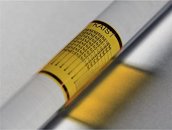Saturday, November 5th 2011
R&D: Memristors And Bendy Memory
Memristors are a fourth class of electric circuit, first hypothesized way back in the 1970's, which are a new addition to the transistors, capacitors, resistors etc that go into making a silicon chip. HP has put a great deal of resources into developing this technology and is expected to release memory-like memristor products in 2013, so it's not far off from commercial deployment. Now however, the Korean Advanced Institute of Science and Technology (KAIST) have found a way to use memristors to make what they describe as a "fully functional" flexible resistive random access memory (RRAM). This memory is built on a plastic substrate and can be randomly accessed, written to and erased. However, as this substrate is flexible, it can be bent and rolled up easily, opening up possibilities for use that haven't even been thought of yet.One of the big holdups for this technology being released into commercial products though, is the problem of major interference between adjacent cells. This causes the performance of such products to fall way below what is required today, as the necessary transistors cannot switch fast enough. However, the team at KAIST claim to have fixed this problem, by developing memory which isn't affected by inter-cell interference. It achieves this improvement by using the properties of memristors alongside a single-crystal silicon transistor on flexible substrates.
Keon Jae Lee from KAIST's Department of Materials Science and Engineering, said that the:
When this technology does finally become available, expect to see a great deal of innovative products, based on the new found freedom of physical flexibility to be made with it. Interesting times are ahead. Sources: TechEye, Tom's Hardware
Keon Jae Lee from KAIST's Department of Materials Science and Engineering, said that the:
result represents an exciting technology with the strong potential to realize all flexible electronic systems for the development of a freely bendable and attachable computer in the near future.At this time, there are no performance benchmarks of this new type of memory, or information of when it will go into production, suggesting that there are still a lot of refinements still needed to make this new technology commercially viable. The research was published in the October issue of Nano Letters ACS (paywall) and the institute's website can be found here: www.kaist.edu
When this technology does finally become available, expect to see a great deal of innovative products, based on the new found freedom of physical flexibility to be made with it. Interesting times are ahead. Sources: TechEye, Tom's Hardware



16 Comments on R&D: Memristors And Bendy Memory
Tom's Hardware claims that KAIST have a press release about this. However, after much frantic googling, I couldn't find it. If you can, I'll update the news story with it.
pubs.acs.org/doi/abs/10.1021/nl203206h
Scroll down to the bottom to download the paper. Uhhh... you have to pay. Scratch that, there's gotta be a free way!Source.
So it has the ability to retain information when "turned off"? That's a pretty good feature...
I personally keep thinking back to the newspapers in Harry Potter and possibly being able to utilize the flexible led screens with new types of literally flexible computer.
But are there any other cool ideas that come from this?
This has interesting links, and BBC News reported a bit on it.
Apparently this is related but I confess I haven't read through it fully.
this might not be a revolution in performance or features, but it could well be used to make some very, very durable electronics.
Think of a tennis ball shaped circuit board, with critical components protected on the inside and a flexible OLED screen on the outside. A small monitor that could be potentially dropped and thrown around without the fear of damage! The possibilities are mind-blowing!
But I think the whole Memristor technology thing is even more amazing.
www.youtube.com/watch?v=6Cf7IL_eZ38
best feature from this will be the fact that it requires no electricity to store the data, so you can have 0W power consumption in standby mode
They could come up with some kind of "floppy disk", which would be durable and convenient.
Think of this: a flexible USB drive (I.E. Flexible solid-state storage). A newspaper or magazine could send video clips along with the articles.